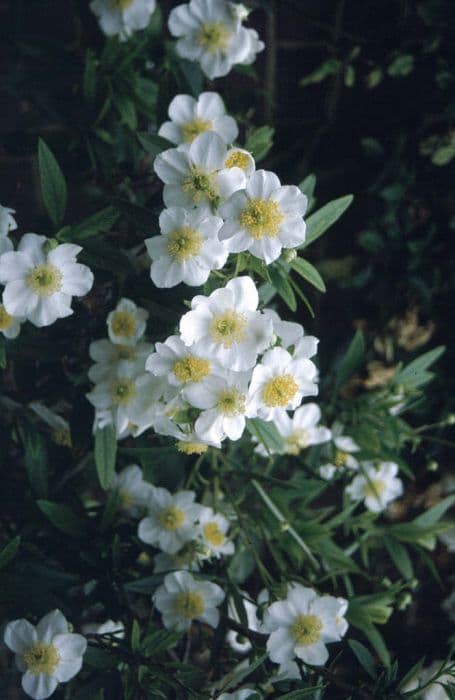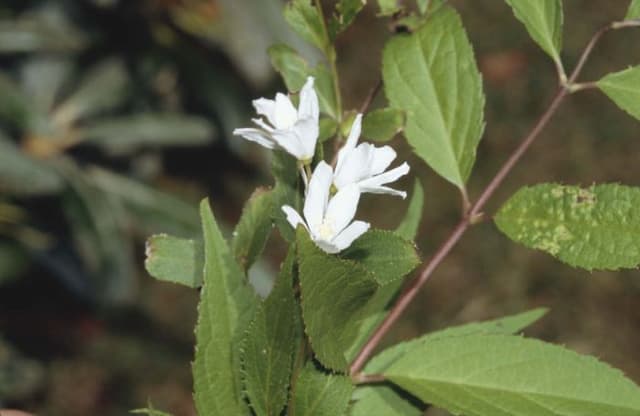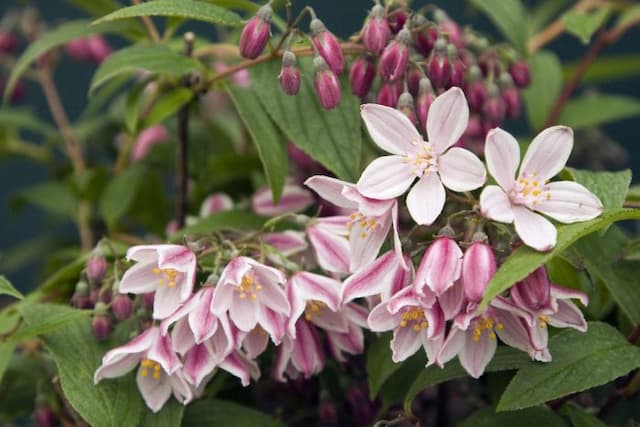Peegee Hydrangea Hydrangea paniculata 'Silver Dollar'

ABOUT
The Hydrangea paniculata 'Silver Dollar', commonly referred to as the panicle hydrangea, is a flowering shrub known for its striking and abundant flower heads. The blooms are notable for their cone-shaped clusters, which are composed of densely packed, small florets. These flower clusters typically start out a soft green color in early summer, transitioning to a creamy white as they mature. As the season progresses into late summer and early autumn, the flowers can take on hues of pink, granting the plant a multi-colored appearance that is both eye-catching and elegant. The leaves of the panicle hydrangea are broad, ovate, and dark green, providing a lush backdrop that accentuates the bright white blooms. The foliage is typically dense, giving the shrub a robust, full look even when it is not in flower. The stems are sturdy, supporting the large flower heads that tend to bloom at the ends of the branches, creating a dramatic display. In addition to its showy flowers, the panicle hydrangea is also appreciated for its ruggedness and ability to flourish in a variety of environmental conditions compared to other hydrangeas. This makes it a popular choice for gardeners looking to add a reliable source of late-season color to their landscapes. Further adding to its aesthetic appeal, the flower clusters of the 'Silver Dollar' can be used in fresh or dried floral arrangements, offering versatility both in the garden and as a cut flower.
About this plant
 Names
NamesFamily
Hydrangeaceae.
Synonyms
Panicle Hydrangea, Peegee Hydrangea, Silver Dollar Hydrangea.
Common names
Hydrangea paniculata 'Silver Dollar'.
 Toxicity
ToxicityTo humans
Panicled hydrangea contains compounds that can release cyanide when chewed or digested. Ingesting any part of the panicled hydrangea can potentially lead to poisoning, with symptoms that may include nausea, vomiting, diarrhea, and depression. The severity of the symptoms can vary depending on the amount ingested and the sensitivity of the individual.
To pets
Panicled hydrangea is also toxic to pets, as it can produce cyanogenic glycosides that might release cyanide when ingested. If a pet, such as a dog or a cat, consumes parts of a panicled hydrangea, they could display symptoms of poisoning which typically include gastrointestinal upset like vomiting and diarrhea. In more severe cases, more toxic effects such as depression and lethargy may be observed. The level of toxicity can depend on the size of the pet and the amount consumed.
 Characteristics
CharacteristicsLife cycle
Perennials
Foliage type
Deciduous
Color of leaves
Green
Flower color
White
Height
6-8 feet (1.8-2.4 meters)
Spread
6-8 feet (1.8-2.4 meters)
Plant type
Shrub
Hardiness zones
3-8
Native area
Asia
Benefits
 General Benefits
General Benefits- Attractive Blooms: Hydrangea paniculata 'Silver Dollar' produces large, showy flowers that can add visual interest to gardens and landscapes.
- Seasonal Change: The blooms shift in color as the seasons change, typically from white to pink, offering a dynamic and evolving display.
- Wildlife Attraction: The flowers can attract pollinators such as butterflies, adding life and movement to the garden space.
- Drought Tolerance: Once established, this hydrangea variety has a good tolerance for drought, reducing the need for frequent watering.
- Versatility: This plant can be used in various garden designs, including borders, foundation plantings, and as a specimen or accent.
- Hardiness: It is cold-hardy and can survive in a range of climates, which makes it suitable for many different garden zones.
- Easy Pruning: 'Silver Dollar' can be pruned back hard if needed, which can rejuvenate the plant and encourage more vigorous growth and flowering.
- Long Blooming Season: It has a long flowering period that lasts through summer and into fall, maintaining garden interest for an extended period.
- Moderate Growth: Hydrangea paniculata 'Silver Dollar' has a moderate growth rate, making it easier to manage while still providing quick coverage.
- Soil Adaptability: It can adapt to a variety of soil types, although it prefers well-drained soil with good moisture retention.
 Medical Properties
Medical PropertiesThis plant is not used for medical purposes.
 Air-purifying Qualities
Air-purifying QualitiesThis plant is not specifically known for air purifying qualities.
 Other Uses
Other Uses- Pressed Flower Crafts: Hydrangea paniculata 'Silver Dollar' flowers can be dried and pressed to create beautiful artwork or to embellish greeting cards and bookmarks.
- Plant Dye: The flowers can be used to make a natural dye for fabrics or paper, resulting in beautiful, soft colors.
- Photography Prop: With their full, rounded flower clusters, these hydrangeas can provide a stunning backdrop or focal point in garden photography.
- Floral Water: Petals can be steeped in water to create a lightly scented floral water for room freshening or linen sprays.
- Candle Embeds: Dried petals can be used in candle making, embedded into the wax around the outside of candles for decoration.
- Garden Mulch: When the blooms are past their prime, they can be trimmed and used as organic mulch for garden beds.
- Soil Acidifier: The decomposed flowers and leaves can help to acidify soil, which is beneficial for acid-loving plants.
- Holiday Decor: Dried hydrangea flowers can be spray-painted and used in holiday wreaths and decorations for a festive appearance.
- Educational Tool: Teaching children about plant biology, pollination, and the life cycle of flowers using hydrangea as an example.
- Frost Protection: In some gardening circles, the bushy nature of the plant is utilized to provide mild frost protection to smaller plants when positioned strategically in the garden.
Interesting Facts
 Feng Shui
Feng ShuiThe plant Hydrangea is not used in Feng Shui practice.
 Zodiac Sign Compitability
Zodiac Sign CompitabilityThe plant Hydrangea is not used in astrology practice.
 Plant Symbolism
Plant Symbolism- Gratitude: The Hydrangea is often given as a sign of thanks or gratitude for understanding and patient individuals.
- Heartfelt Emotions: Representing genuine emotion, the lush blooms can convey deep-felt love or emotion towards someone.
- Apology: It can be given to express an apology, its full blossoms symbolize the fullness of one's heartfelt regret or remorse.
- Boastfulness: In some interpretations, Hydrangeas symbolize boastfulness or vanity due to the abundant petals and showy appearance.
- Frivolity: Some view the Hydrangea as symbolic of frivoloity or the taking of things lightly because of the plant's many blooms and seemingly carefree nature.
- Abundance: The full, bountiful clusters of flowers can represent abundance and prosperity.
- Understanding: Hydrangeas might symbolize a deep understanding and enlightenment, possibly due to their complex structure.
 Water
WaterPanicle hydrangeas, including the 'Silver Dollar', should be watered deeply and thoroughly, ensuring the soil is moist but not waterlogged. They typically require about 1 gallon of water per week, but this can vary with climate conditions. During hot or dry periods, increase watering frequency to twice a week. Ensure the plant has good drainage to prevent root rot. During winter, reduce watering as the plant requires less moisture when dormant.
 Light
LightThe 'Silver Dollar' panicle hydrangea thrives in full sun to partial shade. The best spot for this plant would be an area that receives morning sunlight and some afternoon shade, especially in hotter climates, to prevent leaf scorch.
 Temperature
TemperaturePanicle hydrangeas like 'Silver Dollar' are hardy and can tolerate a range of temperatures. They can generally survive in extreme cold down to about -20°F and in heat up to about 86°F, though they prefer a moderate climate. The ideal temperature conditions are between 65°F and 75°F during the growing season.
 Pruning
Pruning'Silver Dollar' panicle hydrangeas should be pruned to maintain shape and encourage robust blooms. They bloom on new wood, so prune in late winter or early spring before new growth begins. Cut back about one-third of the total height, and remove any dead or crossing branches to improve air circulation. This can be done annually.
 Cleaning
CleaningAs needed
 Soil
SoilThe best soil mix for Panicle Hydrangea ('Silver Dollar') is well-draining, rich in organic material, with a pH range between 5.5 to 6.5, slightly acidic. A mixture of peat, compost, and perlite or vermiculite is ideal to ensure adequate drainage and fertility.
 Repotting
RepottingPanicle Hydrangea ('Silver Dollar') typically requires repotting every 3 to 5 years or when it becomes root-bound. It's best to repot in late winter or early spring before new growth begins.
 Humidity & Misting
Humidity & MistingPanicle Hydrangea ('Silver Dollar') prefers moderate to high humidity levels but is adaptable to average household humidity. Aiming for a range of 40-60% humidity will support healthy growth.
 Suitable locations
Suitable locationsIndoor
Provide indirect light and keep the soil moist for indoor Panicle Hydrangea.
Outdoor
Plant in partial shade, amend soil with organic matter for outdoor Panicle Hydrangea.
Hardiness zone
3-8 USDA
 Life cycle
Life cycleThe life of the Panicled Hydrangea 'Silver Dollar' begins with seed germination in the spring after a period of cold stratification, which breaks the seed dormancy. Seedlings emerge and will establish a root system before sprouting leaves and stems. As the plant matures, it develops a woody framework and produces large conical flower heads composed of sterile florets, typically in mid to late summer. After the flowering stage, the plant enters a phase of senescence where the flowers may turn pinkish or brown as they age and seeds develop. Throughout the fall, the leaves may turn yellow before the plant enters dormancy for the winter. With the return of warmer weather, the cycle restarts as new growth emerges from the previous year's stems.
 Propogation
PropogationPropogation time
Late Winter to Early Spring
The most popular method of propagating Hydrangea paniculata 'Silver Dollar' is through softwood cuttings. This usually occurs in late spring to early summer when the new growth is just beginning to harden but is still flexible. Gardeners will snip a 4 to 6-inch (about 10 to 15 cm) cutting just below a leaf node, remove the bottom leaves, and possibly dip the cut end into a rooting hormone powder to encourage root growth. The cutting is then planted in a pot filled with a mixture of peat and perlite, kept moist, and covered with plastic to maintain humidity. It's crucial to keep the cuttings in indirect light and consistently warm temperatures to ensure successful rooting. After a few weeks, when roots have formed, the plastic is removed, and the new hydrangea plants are gradually acclimatized to outside conditions before planting in the garden.







![Hydrangea [Strong Annabelle]](/_next/image?url=https%3A%2F%2Fplants-admin.emdemapps.com%2Fimages%2Fplants%2F%2Fimages%2F604b54db37d34.png&w=640&q=75)

